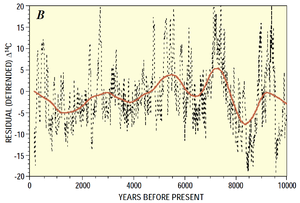Yes, we have all been waiting for the Durham Report !
Thanks.
<<You might be surprised to learn that we were right about EVERY THING!!>>
I am suitably shocked and awed -g-
The Hallstatt cycle (2400 yrs) looks to have been independently derived from several directions. Looks real as any.
Formerly About Advanced Micro Devices Message Board - Msg: 35028006
One of a number of cycles that reset life processes on Earth. Even if Al Gore says they are true or not -g-
Along with the approximately 11-year sunspot cycle, a number of additional patterns and cycles have been hypothesized. [8]
Waldmeier effect[ edit]
The Waldmeier effect describes the observation that the maximum amplitudes of solar cycles are inversely proportional to the time between their solar minima and maxima. Therefore, cycles with larger maximum amplitudes tend to take less time to reach their maxima than cycles with smaller amplitudes. [45] This effect was named after Max Waldmeier who first described it. [46]
Gnevyshev–Ohl rule[ edit]
Main article: Gnevyshev–Ohl rule
The Gnevyshev–Ohl rule, in its original formulation, states that for the summary index of solar activity over the 11-year cycle, there is a close connection in pairs of even and subsequent odd cycles, while opposite pairs exhibit no such connection. [47]
Gleissberg cycle[ edit]
The Gleissberg cycle describes an amplitude modulation of solar cycles with a period of about 70–100 years, or seven or eight solar cycles. It was named after Wolfgang Gleißberg. [8] [48] [49] [50]
As pioneered by Ilya G. Usoskin and Sami Solanki, associated centennial variations in magnetic fields in the corona and heliosphere have been detected using carbon-14 and beryllium-10 cosmogenic isotopes stored in terrestrial reservoirs such as ice sheets and tree rings [51] and by using historic observations of geomagnetic storm activity, which bridge the time gap between the end of the usable cosmogenic isotope data and the start of modern satellite data. [52]
These variations have been successfully reproduced using models that employ magnetic flux continuity equations and observed sunspot numbers to quantify the emergence of magnetic flux from the top of the solar atmosphere and into the heliosphere, [53] showing that sunspot observations, geomagnetic activity and cosmogenic isotopes offer a convergent understanding of solar activity variations.
Suess cycle[ edit]
The Suess cycle, or de Vries cycle, is a cycle present in radiocarbon proxies of solar activity with a period of about 210 years. It was named after Hans Eduard Suess and Hessel de Vries. [49] Despite calculated radioisotope production rates being well correlated with the 400-year sunspot record, there is little evidence of the Suess cycle in the 400-year sunspot record by itself. [8]
Other hypothesized cycles[ edit]
 2,300 year Hallstatt solar variation cyclesPeriodicity of solar activity with periods longer than the solar cycle of about 11 (22) years has been proposed, including: 2,300 year Hallstatt solar variation cyclesPeriodicity of solar activity with periods longer than the solar cycle of about 11 (22) years has been proposed, including:
- The Hallstatt cycle (named after a cool and wet period in Europe when glaciers advanced) is hypothesized to extend for approximately 2,400 years. [54] [55] [56] [57]
- In studies of carbon-14 ratios, cycles of 105, 131, 232, 385, 504, 805 and 2,241 years have been proposed, possibly matching cycles derived from other sources. [58] Damon and Sonett [59] proposed carbon 14-based medium- and short-term variations of periods 208 and 88 years; as well as suggesting a 2300-year radiocarbon period that modulates the 208-year period. [60]
- Brückner-Egeson-Lockyer cycle (30 to 40 year cycles).
- A 2021 study investigates the changes of the Pleistocene climate over the last 800 kyr from European Project for Ice Coring in Antarctica (EPICA) temperature ( dD) and CO2-CH4 records [61] by using the benefits of the full-resolution methodology for time-series decomposition singular spectrum analysis, with a special focus on millennial-scale Sun-related signals. [62] The quantitative impact of the three Sun-related cycles (unnamed ~9.7-kyr; proposed 'Heinrich-Bond' ~6.0-kyr; Hallstatt ~2.5-kyr), cumulatively explain ~4.0% (dD), 2.9% (CO2), and 6.6% (CH4) in variance. A cycle of ~3.6 kyr, which is little known in literature, results in a mean variance of 0.6% only, does not seem to be Sun-related, although a gravitational origin cannot be ruled out. These 800-kyr-long EPICA suborbital records, which include millennial-scale Sun-related signals, fill an important gap in the field of solar cycles demonstrating for the first time the minor role of solar activity in the regional budget of Earth's climate system during the Mid-Late Pleistocene.
|





